MobileHelp Medical Alert System Review 2025
Our tech experts appreciated MobileHelp’s options for couples, variety of systems, and affordable prices.
SeniorLiving.org is supported by commissions from providers listed on our site. Read our Editorial Guidelines
MobileHelp offers a diverse lineup of medical alert systems that has expanded over the years to meet the needs of those who are aging in place, from in-home and on-the-go units to systems designed for two users with prices starting at $24.95 per month.
After testing MobileHelp’s at-home and on-the-go packages, I found that their systems are competitively priced (especially for spouses) with some great add-on features. The main downside is the buying process, since it was initially challenging to differentiate between their product offerings. With a few questions for customer service, however, I landed on the right products to test and was happy with the results. Read on as I cover everything you need to know about MobileHelp, from choosing a package that’s right for you to testing your new system!
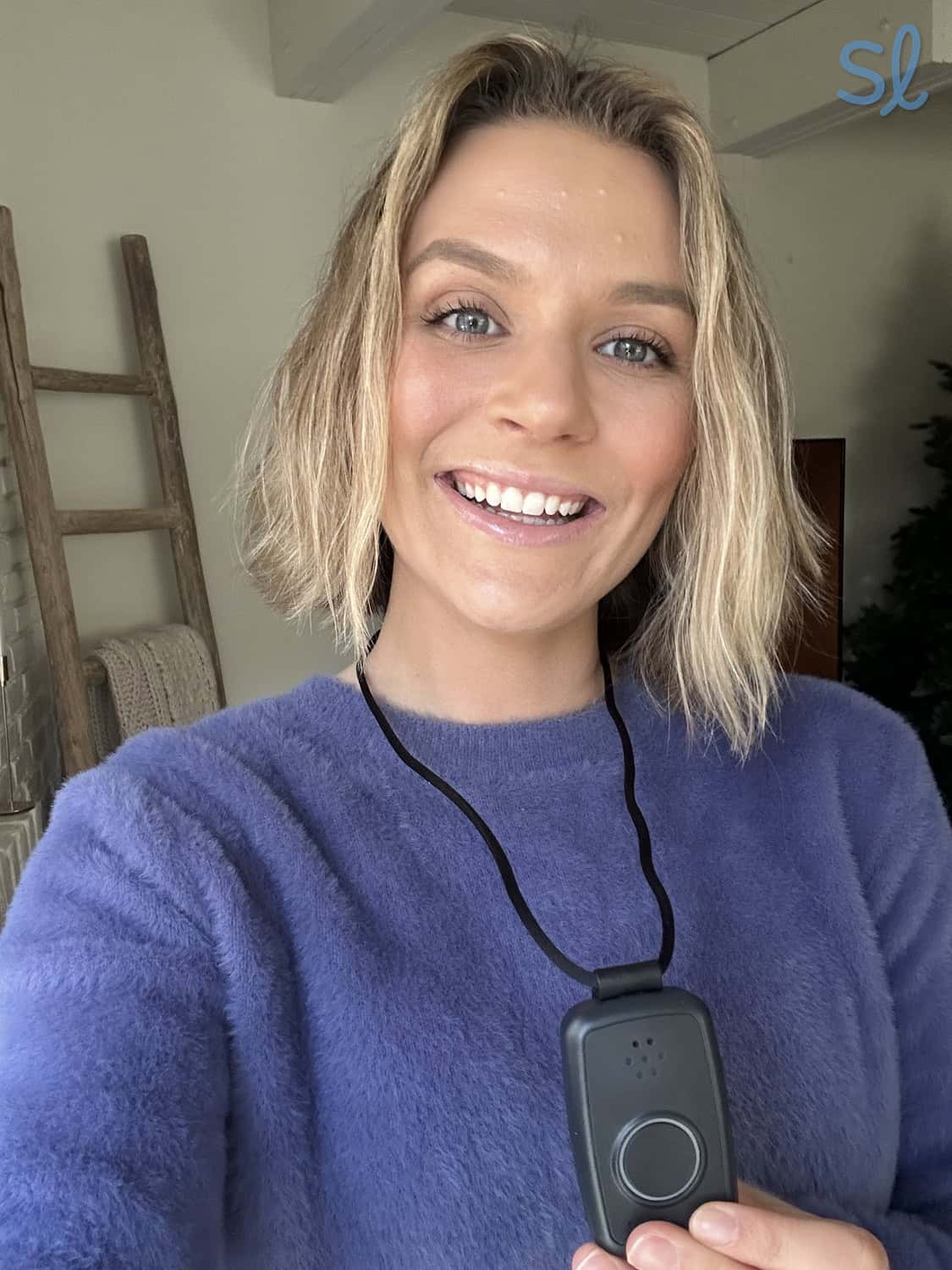
Using the MobileHelp Micro system

Pros About MobileHelp
- Variety of options: With six medical alert systems to choose from, you will likely find something to meet your needs.
- 30-day money-back guarantee: MobileHelp lets you give their systems a test drive for a month without any risk, which is a must-have.
- Options for multiple users: I was happy to find that MobileHelp offers affordable systems built for two users. It eliminates paying double for a two-person household.
- Competitive pricing: MobileHelp has cheaper starting rates than most of the competition, including Lifeline's prices. For anyone on a tight budget, MobileHelp has affordable in-home and on-the-go options.
- Coverage range: Both of MobileHelp’s at-home systems have excellent in-home range, from 600 to 1,400 feet.
Cons About MobileHelp
- Smartwatch discontinued: Unfortunately, as MobileHelp’s product offerings evolved over the years, the company discontinued its smartwatch. The watch was a more discreet option with a built-in alert system for active users. If you’re set on a smartwatch, check out our review of Medical Guardian for a look at their MGMove smartwatch system.
- Landline in-home system doesn’t offer fall detection: MobileHelp’s landline option, Classic Landline, doesn’t have the option to add automatic fall detection. That's pretty unusual for the industry. Since falls are most common in the home, it’s an important drawback to consider.
Overview of MobileHelp
The Buying Experience
MobileHelp’s product line can be difficult to navigate, in part because the names aren’t self-explanatory. I recommend calling the company for help with choosing a system because speaking with a representative is an easy way to clear up any confusion and find the best deal. When I called, the representative let me know there was a monthly discount if I paid annually instead of monthly.
Quick Fact: When I tested MobileHelp’s medical alert systems, I found that the average response time was around 17 seconds. The industry average is between 15 and 45 seconds, so MobileHelp is fast.
During my call, the representative explained each system’s features and helped me choose which one fit my needs. I wanted to test a cellular system designed for at-home and on-the-go use, so she recommended I try the Home Duo Bundle, which comes with an in-home base station and mobile unit. Overall, I was satisfied with my customer-service experience, and all of my questions were answered.
Setting Up My System
My Home Duo Bundle package came with a base station, a wearable pendant, a mobile help button, and a charging cradle. All I had to do was plug the base station into an outlet, charge the mobile unit, and put on the pendant. From start to finish, I was set up in under five minutes.
You’ll need to test both the base station and the mobile unit. To test the base station, I simply pressed the Test button. The base station prompted me to press the button on my pendant or the emergency button on the base station itself. If you hear “User auto test completed,” you know the base station and pendant are working properly. You can also do that after unplugging the base station to make sure the backup battery is working.
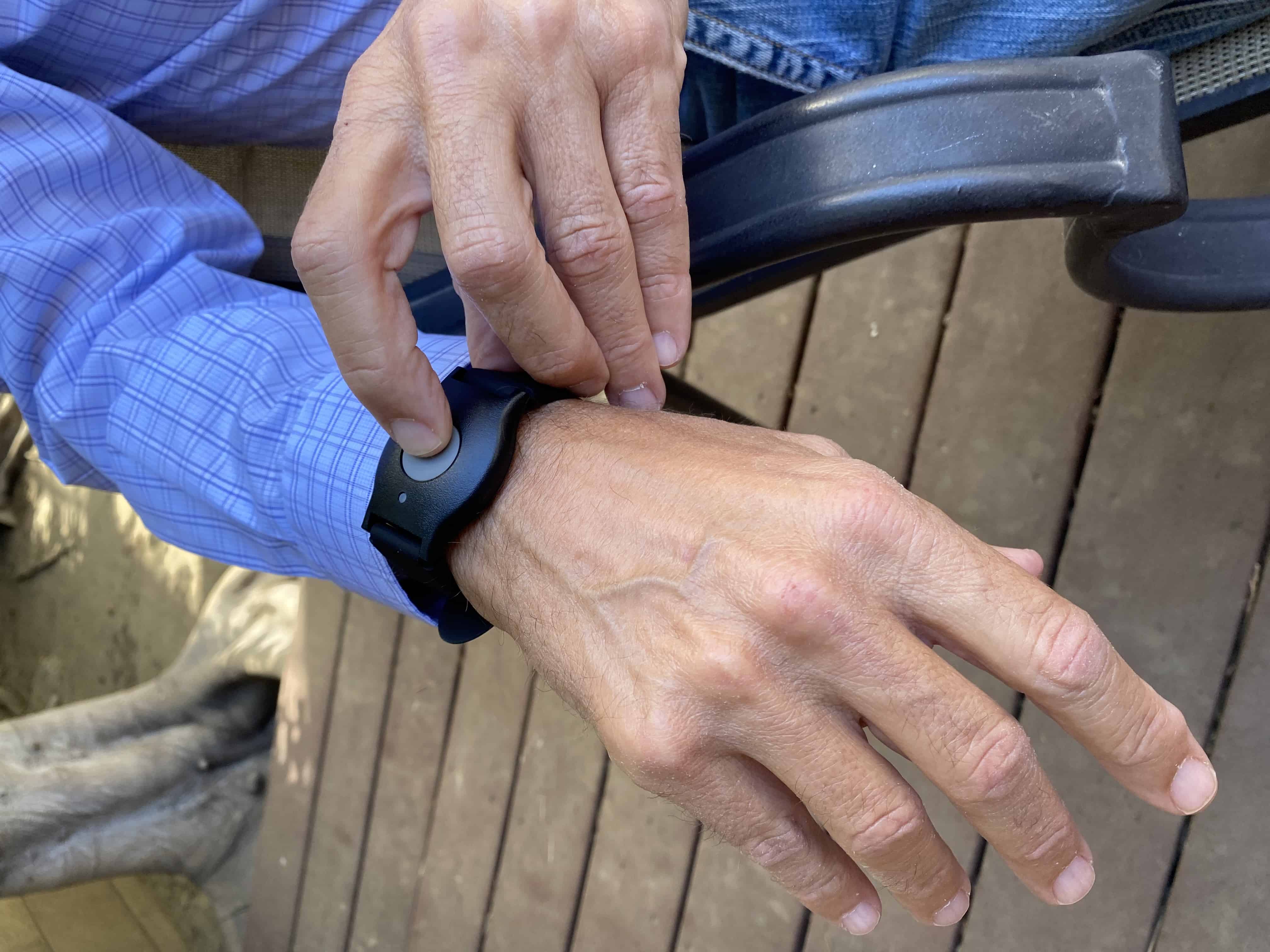
Testing out MobileHelp's wearable help button
To test the mobile unit, simply hold down the mobile help button for two seconds and release it. It will connect to the emergency-response center, and you’ll communicate through the mobile device itself (like a walkie-talkie) to an agent. The U.S.-based monitoring center answered my call and asked if I needed help. I let them know I was running a test, and that was it! MobileHelp recommends testing your system once per month to ensure that your equipment is working properly.
Contracts and Warranty
MobileHelp’s plans come with a lifetime warranty, so whether you’re a customer for two or 20 years, you’ll be set. Like most medical alert system warranties, the protection covers normal wear and tear. MobileHelp offers Connect Premium, a protection plan that costs $6 per month for equipment that is lost, stolen, or damaged. In addition to this protection, Connect Premium provides discounts on extra products and services and also locks in your monthly rate for two years.
It is good to know that MobileHelp doesn’t require long-term contracts, but they encourage you to choose a quarterly, semiannual, or annual payment plan by waiving the activation fee and offering discounted rates. If you cancel your service, MobileHelp will issue a prorated refund for any unused service for quarterly, semiannual, and annual payment plans.
MobileHelp's Equipment at a Glance
| MobileHelp product | Monthly price | Features | Cellular or landline |
|---|---|---|---|
| Classic Cellular | $24.95 |
|
Cellular |
| Classic Landline | $24.95 |
|
Landline |
| MobileHelp Solo | $34.95 |
|
Cellular |
| MobileHelp Micro | $34.95 |
|
Cellular |
| Home Duo Bundle | $44.95 |
|
Cellular |
| Mobile Duo Bundle | $49.95 |
|
Cellular |
MobileHelp System and Product Details
Classic Cellular
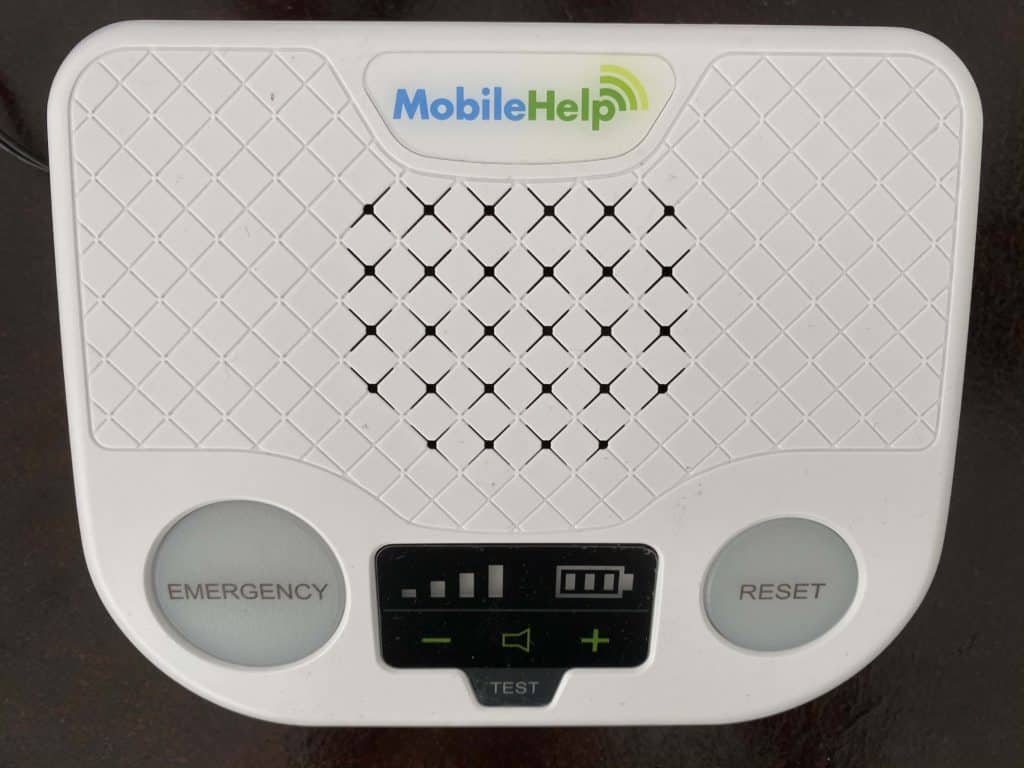
MobileHelp Classic base unit
Cost
The Classic Cellular is my pick for people on a budget. The monthly fee starts at $24.95, which is a real bargain. For comparison, Bay Alarm Medical’s prices for in-home systems start at $19.95 per month, while Medical Guardian’s monthly cost is $31.95.
Equipment
The Classic Cellular comes with a base station and power cord plug that includes two-way talk. You also get your choice of a waterproof help pendant worn on a lanyard, black wristband, or white wristband. I like the breakaway neck lanyard that connects with magnets, which is a good safety feature to prevent strangulation. The lanyard is light and easy to wear. My system also came with a lightweight wristband, but I didn’t like that you can’t hide the buckle end under your wrist like you can with Apple watches.
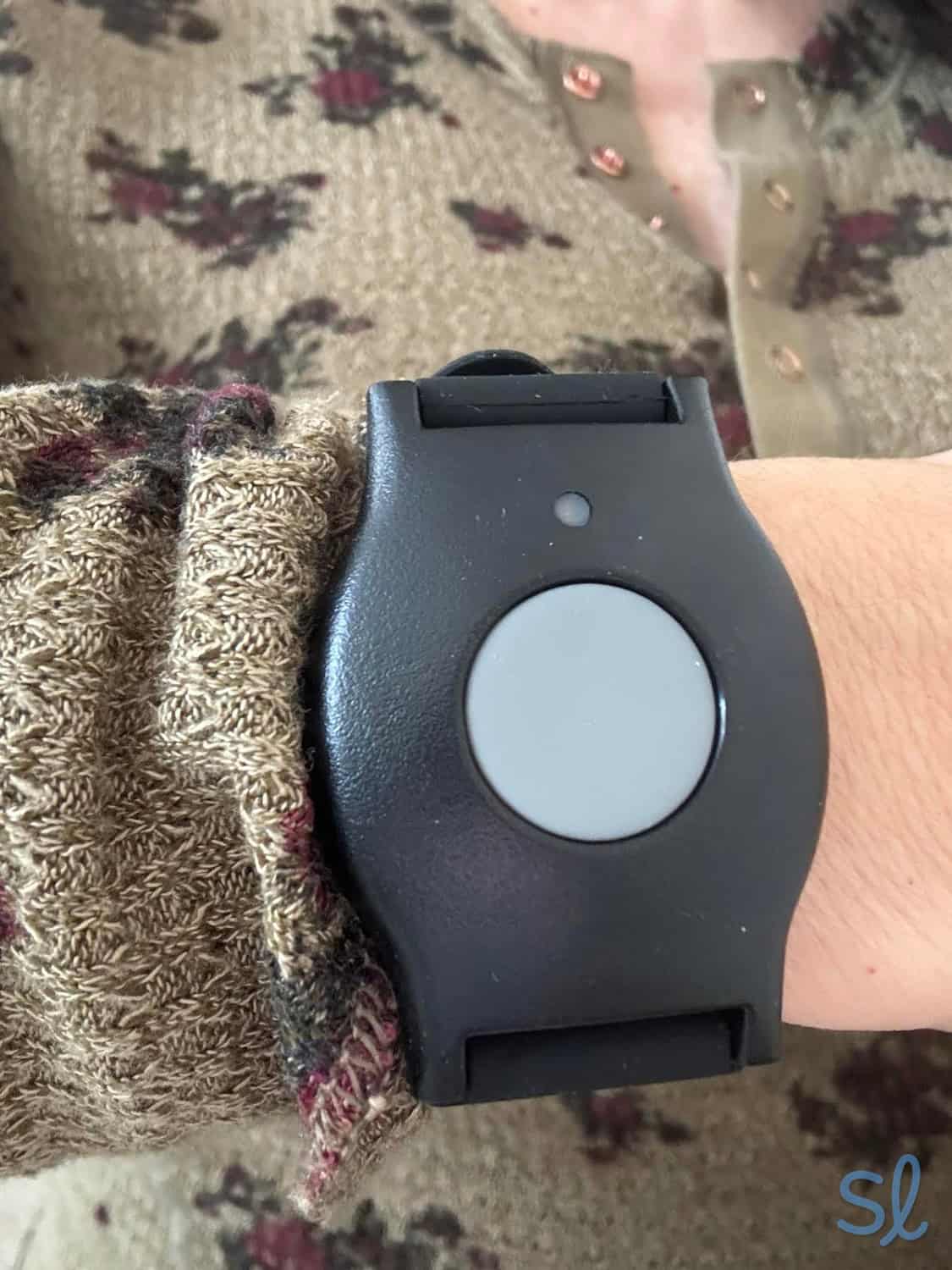
Wearing a MobileHelp button as a wristband
The at-home cellular system looks like an answering machine but not as bulky. The base station has a large, red illuminated button for emergencies and a slightly smaller blue illuminated button for resetting the device. The display screen on the front is very nice and has volume-control icons you can control by pushing the – or + sign. You can see your battery level and signal strength on the display, and there’s also a test button directly below it. Once charged, my signal strength showed three bars of reception.
Whether you’re a master chef in the kitchen or you have a green thumb and spend most of the day in the garden, you’ll be covered anywhere within 1,400 feet of the base station. During an emergency, press the help button on either the pendant or the base station to be connected to MobileHelp’s response center in a matter of seconds. In a power outage, the base unit’s backup battery will kick in and last up to 24 hours. It took about three hours for my base station to fully charge before I unplugged it.
Service and Monitoring
To make a test call, I pushed the help button for a second. The device announced that a call was in progress. Then it said, “Call connected. Please stand by for an operator.” It took up to 30 seconds to connect to an operator during my tests.
Classic Cellular is great for those who rarely leave home and live in an area with solid AT&T coverage. In addition to 24/7 monitoring, MobileHelp offers fall detection through a wearable neck pendant. The pendant can detect falls and alert the monitoring center, even when you’re unable to press your help button. This service costs an additional $11 per month, which is similar to the industry standard of around $10 per month.
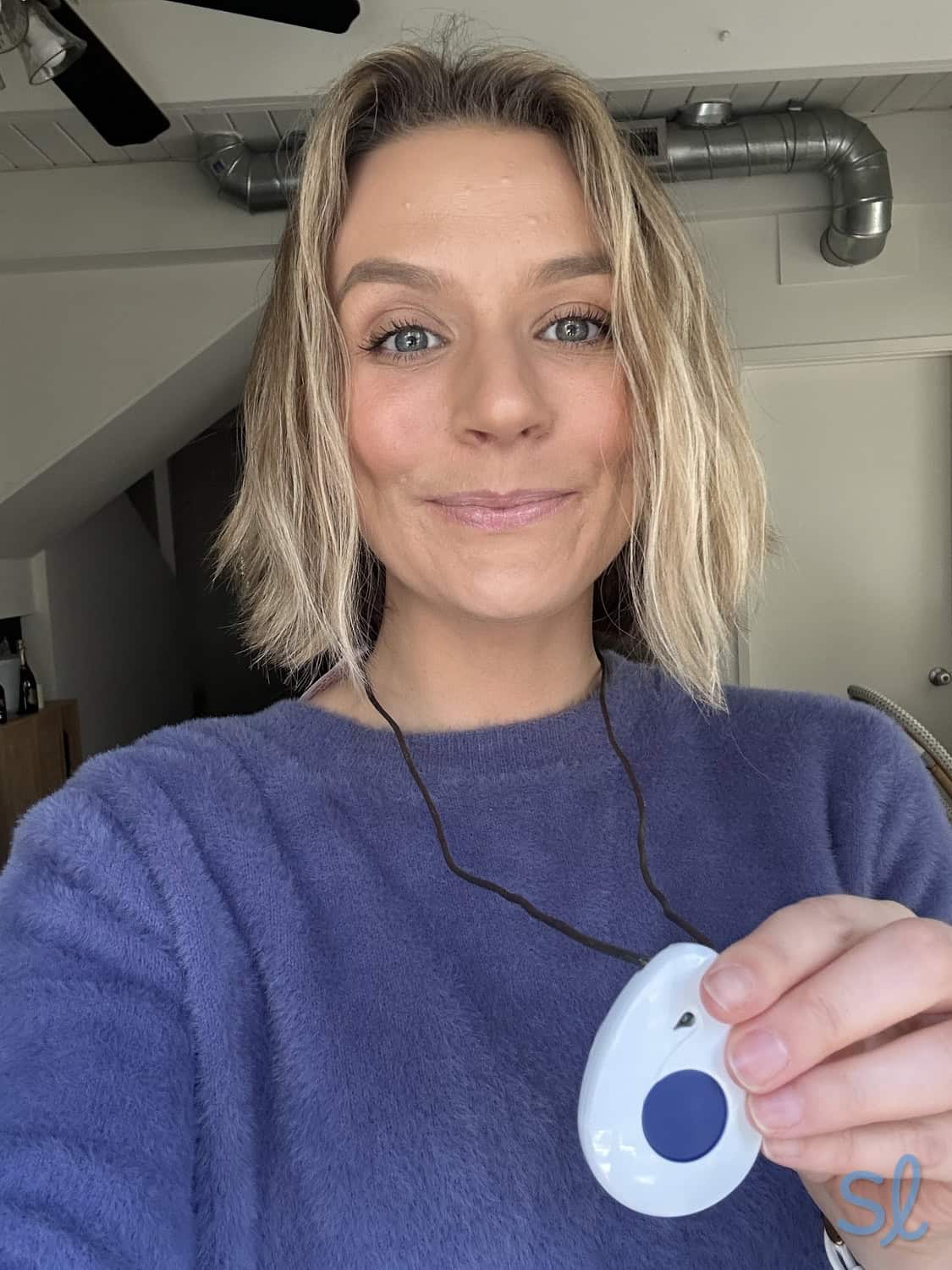
Using MobileHelp's fall detection pendant
Classic Landline
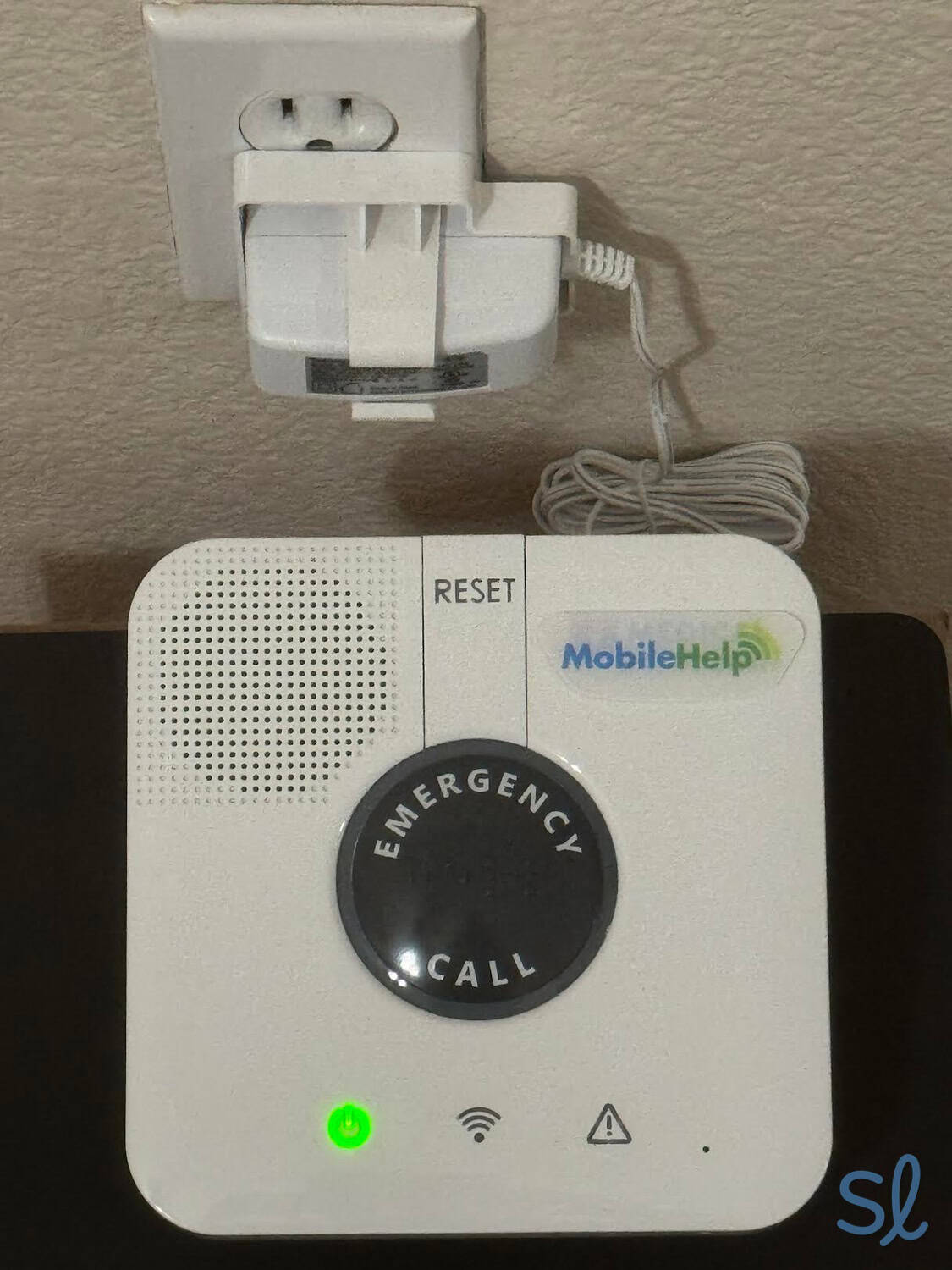
Using MobileHelp s Classic Landline system
Cost
At $24.95 per month, the Classic Landline is a cost-effective system compared to many other at-home systems. You can also save a few bucks per month when you opt for a payment plan other than the month-to-month option.
Equipment
The Classic Landline is an in-home system best for people who spend most of their time in the house. Except for the connection type and the base station’s appearance, it works exactly the same as the Classic Cellular. It comes with a base station, a power cord, a 6-foot phone cord, and a neck pendant. The base station features two-way communication, a 32-hour rechargeable battery, and a 1,300-foot range for in-home use.
The system has a lightweight, square-shaped base station with a large, round, black button in the center that says “emergency call” in big letters. Above it is a small “reset” button. I appreciated how large and clearly labeled all the buttons were to eliminate any confusion during an emergency. Below the large, round button is the power light and reception indicators. Once the power and communication indicators on the base station turned solid green and stopped flashing, my system was ready to use.
FYI: If you live in an area with poor AT&T service, check out our Lively review. The company’s systems run on Verizon’s network.
Service and Monitoring
The range from the pendant to the base station is 1,300 feet, and the neck help button and wristband battery lasts up to five years. MobileHelp recommends letting the pendant rest on your breast bone to lower the risk of false alarms. Unfortunately, you can’t cancel a false alarm once a call has been placed, so you will need to let the operator know it was a false alarm.
If you live in an area with spotty cellular coverage, Classic Landline is a good option. The system runs on a landline connection, so you won’t have to worry about poor coverage during an emergency. One thing to note with the landline system is that fall detection is not available. Unfortunately, you can’t add automatic fall detection to this system.
MobileHelp Solo
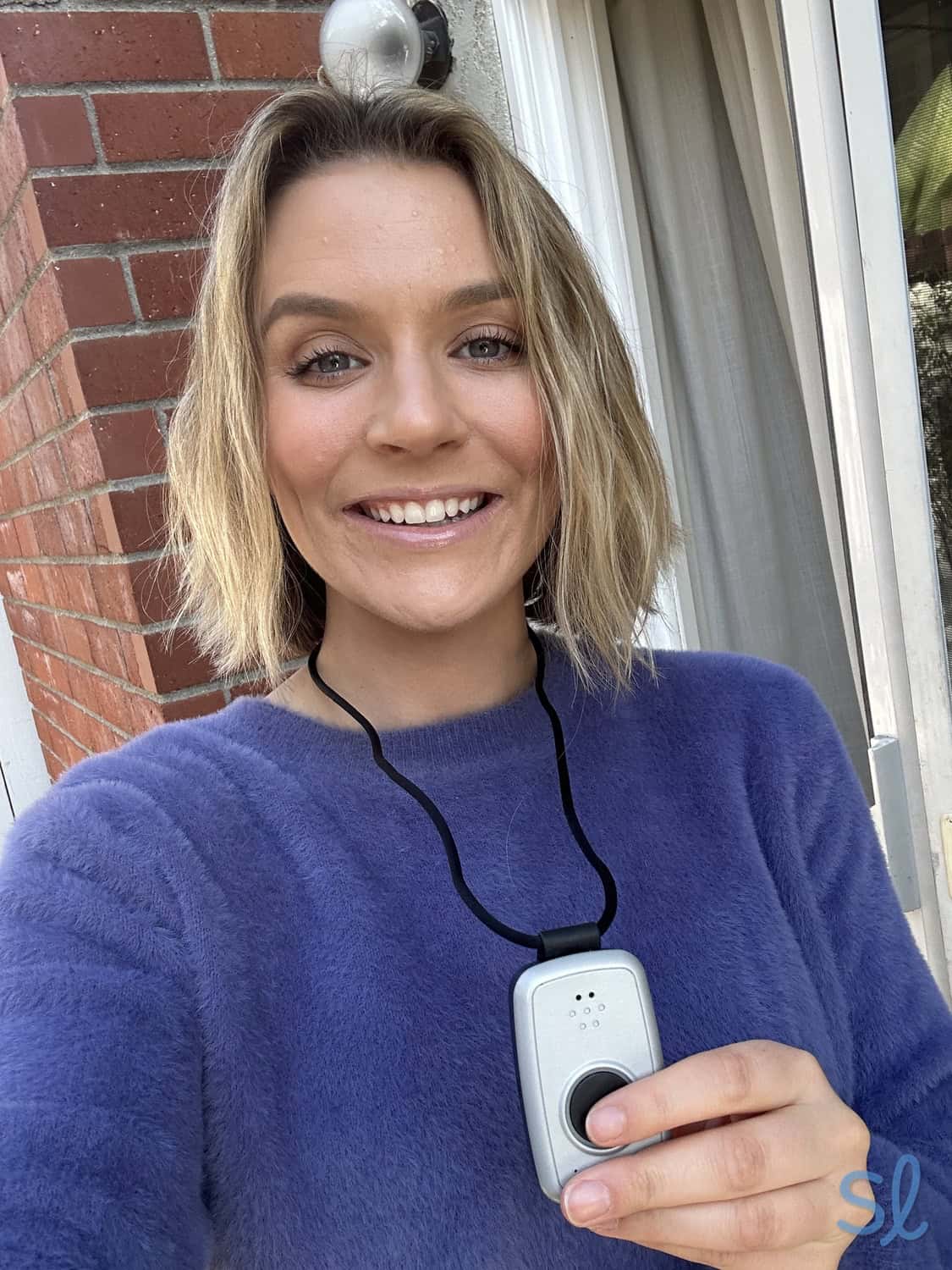
Testing out the MobileHelp Solo system
Cost
At $34.95 per month, the MobileHelp Solo is right in line with the price of other on-the-go brands. There are discounts available if you choose a payment plan other than the monthly option. For a closer look at cost and getting the best deal with MobileHelp, visit our MobileHelp pricing guide.
Equipment
MobileHelp Solo is my pick for single users who spend time out on the town, whether it’s shopping, hiking, or catching up with friends. MobileHelp Solo comes with a charging base and mobile device attached to a lanyard.
To charge it, I just put the device in the charging base and plugged it in. It shows multiple colors on the button. When the light was solid red, that meant it was charging. Once it was fully charged, the light turned green. It took about three hours for the Solo to fully charge. MobileHelp recommends charging the unit every night so you’ll have a full charge during the day. My system’s light blinked red when I had only one hour of battery life left. I appreciated the low-battery notification because it helped me remember to charge my device.
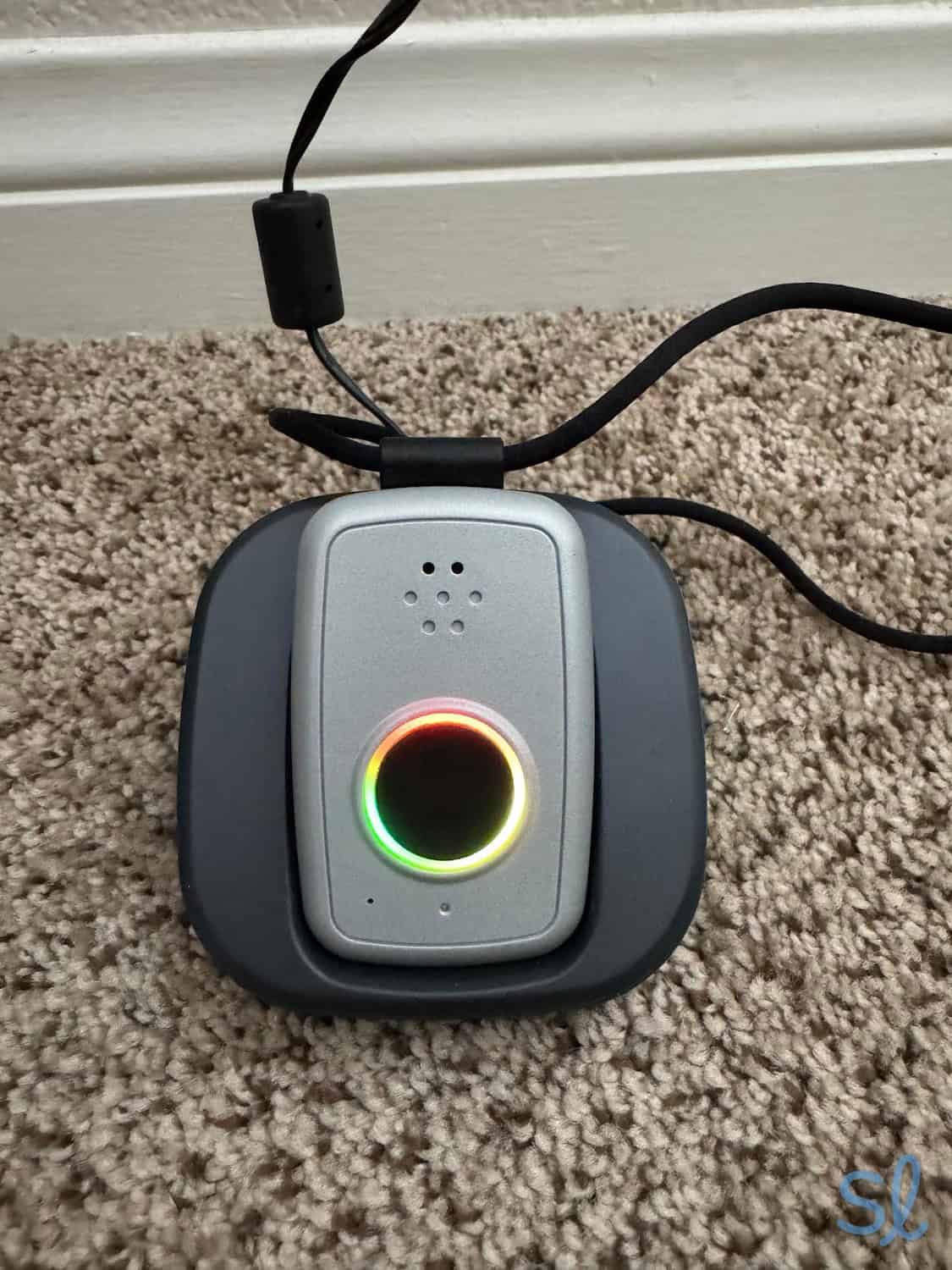
Charging MobileHelp's Solo system
The system can also be used in the house. I don’t know about you, but I hate clutter. MobileHelp Solo is silver and wearable, so you don’t have a bulky base station taking up precious counter space. I found it quite large and heavy to wear as a lanyard compared to some other mobile devices, however, including the smaller, lighter SOS Micro from Bay Alarm Medical.
Pro Tip: Each MobileHelp system comes with access to MobileHelp Connect, an online portal that offers both standard (free) and premium (with an additional charge) features. Standard features include caregiver alerts, location detection for caregivers, and a MobileVitals section to store important health information.
Service and Monitoring
With MobileHelp Solo, you are able to access two-way talk, GPS location detection, and optional fall detection through a separate pendant. Just like MobileHelp’s other on-the-go systems, it runs on AT&T’s network.
To test the device, I pressed the button for five seconds. I heard a voice announce that a call was in progress, and then it said, “Call connected. Please stand by until we connect you to a care specialist.” An operator then asked if I needed help. If you don’t say you’re just testing the device, it will connect you to a live operator. During my test, it took 30 seconds.
MobileHelp Micro
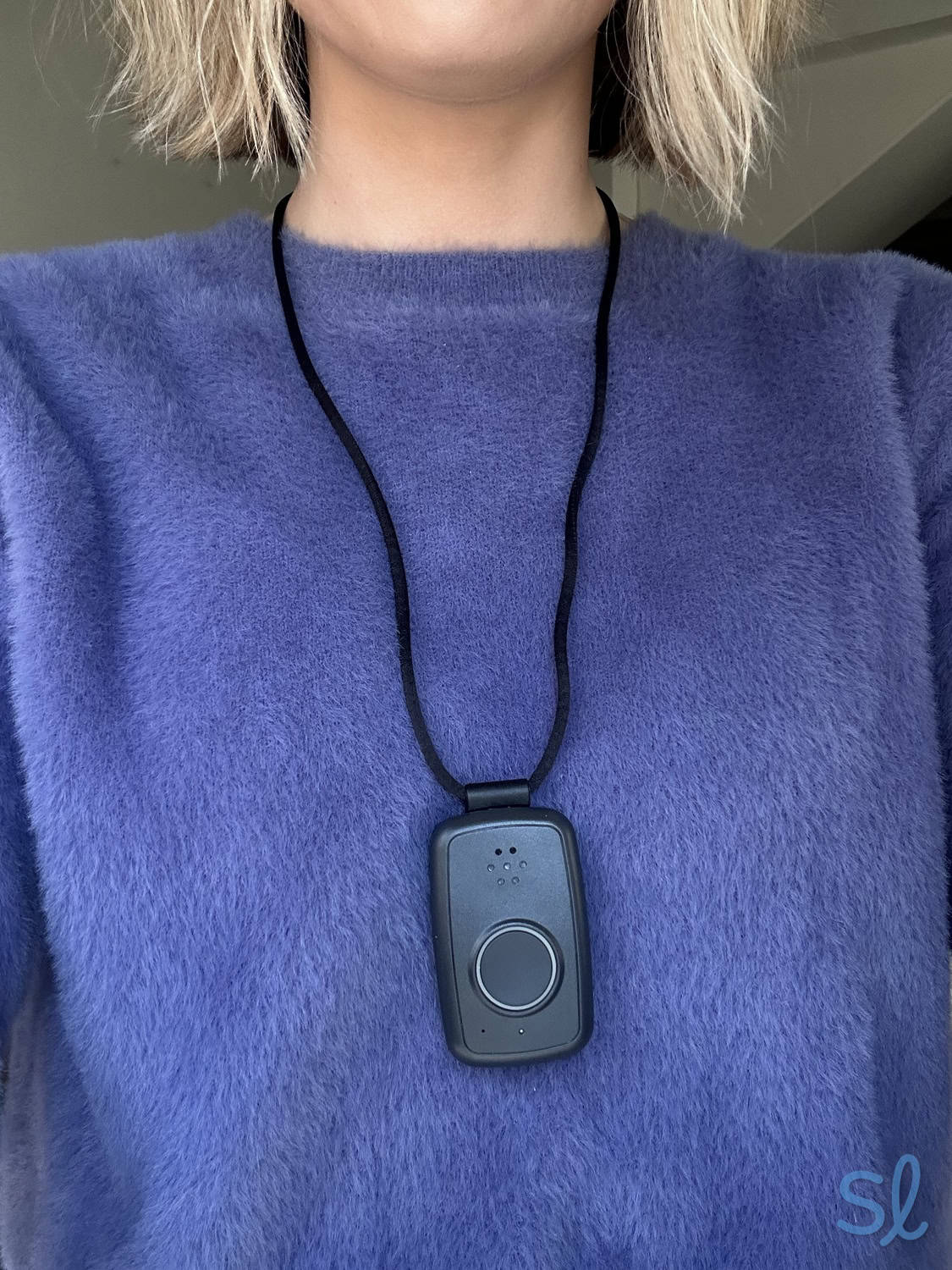
Wearing MobileHelp's Micro system
Cost
In line with the cost of other advanced on-the-go systems, the monthly monitoring fee for the MobileHelp Micro is $34.95. The system doesn’t have an activation or equipment fee, and you can add Connect Premium for $6 per month to protect your equipment from damage or theft.
Equipment
The MobileHelp Micro is a sleek, black device with a single large button in the center. The system comes with two-way talk, GPS location detection, and optional fall detection. My Micro package arrived with a detachable lanyard, charging station and free lockbox. Simply throw on your Micro like a necklace, and take it with you wherever you go for 24/7 protection.
I found the device heavy and bulky compared to some mobile systems, but I could still tuck it under a sweater for discretion. The setup and charging process for the Micro was the same as the Solo. It took around three hours for my system to fully charge, and the battery lasted about 36 hours.
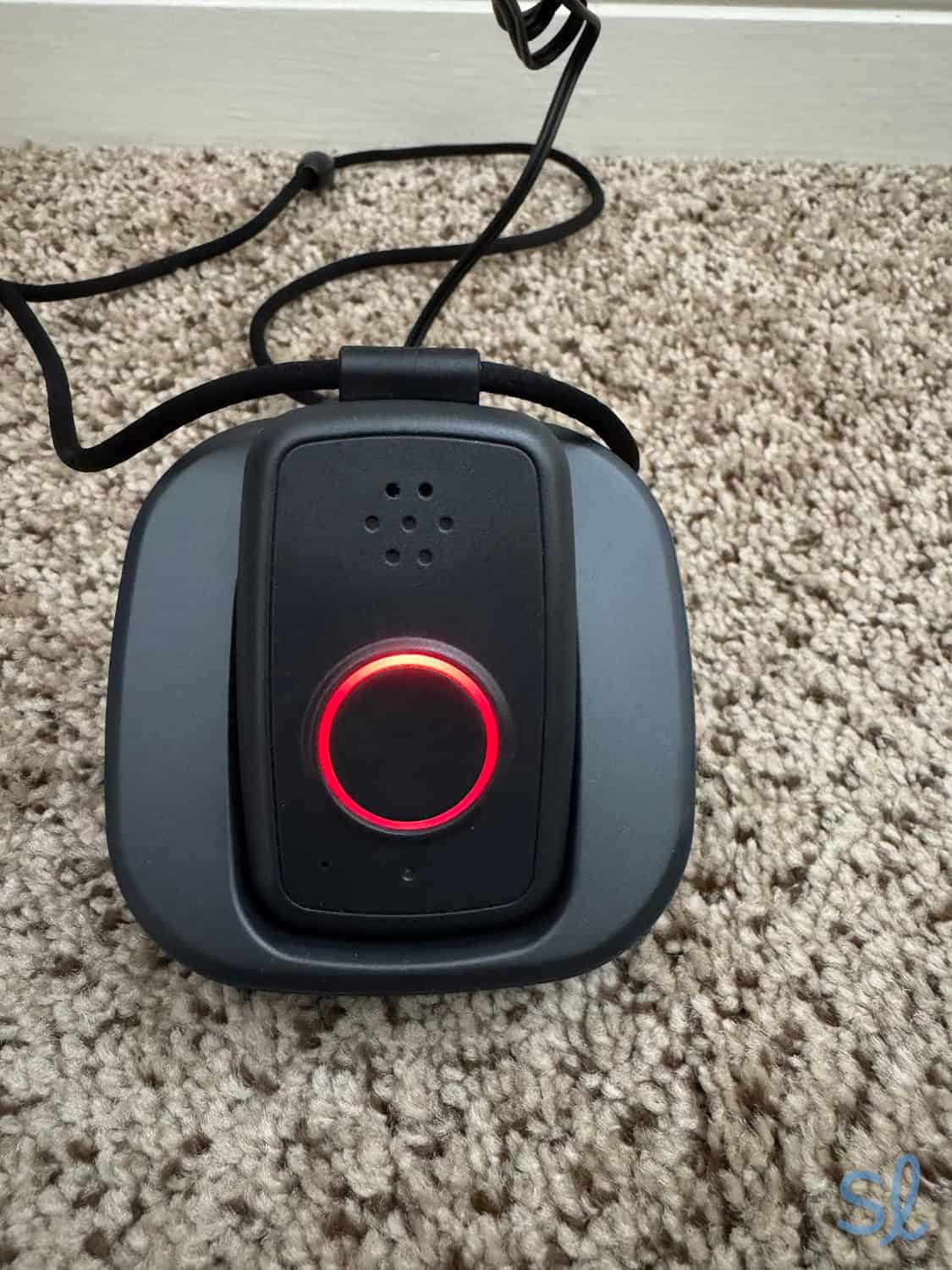
Charging the MobileHelp Micro system

When I spoke with customer service, the representative recommended keeping the device on the charger at night just to make sure it is always at full charge and ready for any potential emergency situations.
Service and Monitoring
With AT&T cellular service, you can travel just about anywhere you like and still be protected. No cellular contract is required, and the device will operate using MobileHelp’s cellular plan. One of my favorite things about MobileHelp’s monitoring was that when I made a test call, I received personalized service. The operator immediately addressed me by name and knew my address, which made me feel like I was in good hands.
Home Duo Bundle
 Cost
Cost
At $44.95 per month, this system comes with an in-home base unit and the convenience of a mobile unit for when you're away from home. Considering many on-the-go systems cost between $35 and $40 per month, $44.95 for a hybrid system with at-home and on-the-go protection is a good deal. You can use the in-home system and mobile alert device simultaneously. Keep in mind that there’s just one mobile device, so only one person at a time can use the system outside the home.
Equipment
This is the system I tested, and it comes with an in-home base station, two waterproof pendants, a mobile alert device (which functions as a second base station on the go), and a charger for the mobile device.
I set up the base station in the living room, a central location, and made a test call from the bedroom to confirm it was within range. Later, I took the mobile unit on a walk around the block, and it worked just as seamlessly. Both provide two-way communication to MobileHelp’s response center in case of an emergency.
The battery life of the mobile unit is 24 hours. Mobile units from other providers have battery lives ranging from one to five days, so this is decent. I’d recommend charging your unit every night when you go to bed. The extra help pendants are lightweight and don’t require a new battery for up to five years.
Service and Monitoring
Both the at-home and mobile systems use AT&T cellular. When traveling with the on-the-go system, I was able to use my mobile device, as long as the area I was visiting had AT&T coverage. A fall-detection pendant is available for an additional $11 per month.
Mobile Duo Bundle
 Cost
Cost
At $49.95 per month, you are basically getting two on-the-go systems for nearly the price of one. Like MobileHelp’s other systems, discounts are available with select payment plans.
Equipment
Mobile Duo is an excellent fit for couples or roommates who are active and spend most of the day away from home. I love the flexibility the system offers. If you go fishing with your buddies at the same time your wife goes to her book club or bunco group, you’ll both be covered.
The system comes with two of the same mobile units that come with MobileHelp Duo and two help buttons and chargers. Unlike MobileHelp Duo, Mobile Duo doesn’t come with an in-home base unit, but you can easily use your mobile unit at home.
Service and Monitoring
The mobile devices use AT&T coverage, one of the most widely used cellular services in the industry. The mobile devices offer GPS location detection, and you can add fall detection (which costs an additional $11 per month) through a separate pendant.
Compare MobileHelp to Other Providers
Add-on Features and Accessories
Fall-Detection Pendant
Fall detection is the most important add-on. Falls can easily happen in the shower, on the porch steps, or anywhere else in the home. MobileHelp offers fall detection for an extra $11 per month with any system except the Wired Home. A quarter of adults ages 65 or over falls each year, so fall detection is an essential feature.1
Wall Buttons
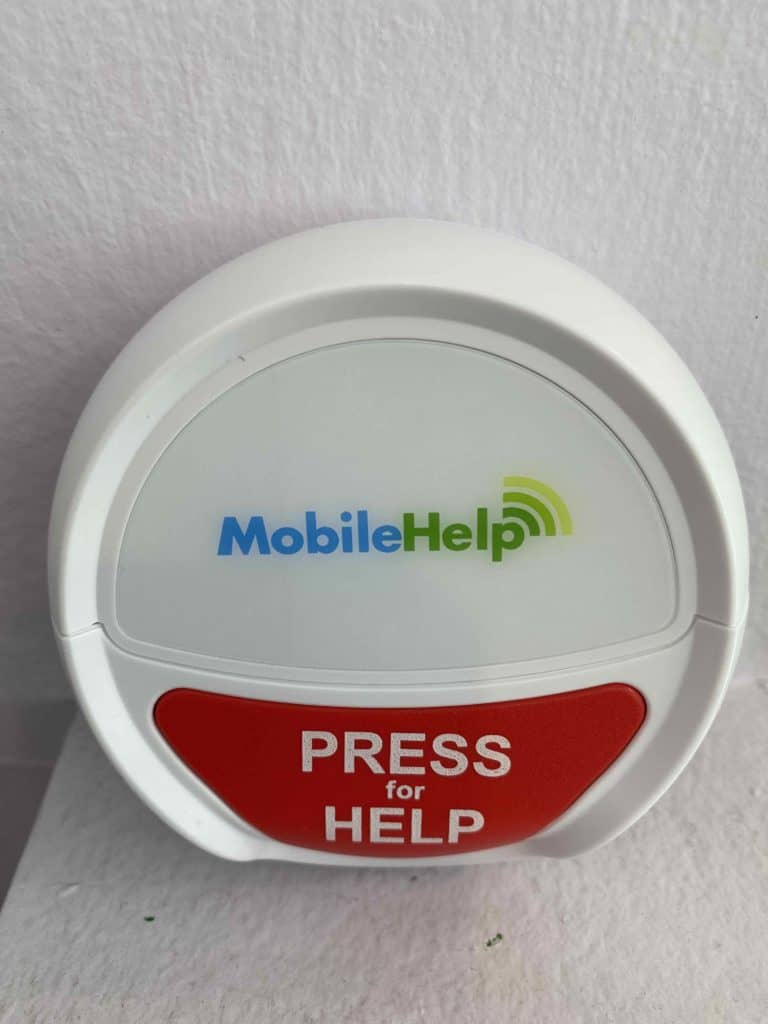
MobileHelp wall button
You can stick wall buttons anywhere — in the bathroom, at the bottom of a staircase, or by the bed. All you need to do is press the help button, and it will connect to your base station to call for help. An additional help button costs an extra $2 per month, and a waterproof wall button costs $2.95 per month.
MobileHelp Connect Premium
MobileHelp Connect Premium offers online tools and discounts for subscribers and their families. The add-on also includes discounts on extra equipment and a warranty that covers any lost or damaged equipment, and it lets you lock in your monthly rates for two years. MobileHelp Connect Premium is $6.99 per month.
MobileHelp vs. the Competition
MobileHelp has six at-home and on-the-go systems for aging adults. Their systems have a lot to offer, but let’s see how they compare to the competition.
MobileHelp vs. Bay Alarm Medical
Bay Alarm Medical’s 1,000-foot coverage for their in-home system doesn’t quite compare to MobileHelp’s range of 1,400 feet, but they provide a wider selection of devices, including both landline and cellular-based home systems, two mobile options, and a smartwatch. Bay Alarm Medical also has an excellent mobile app for caregivers that features tracking, notifications for emergency calls, and more. MobileHelp’s app isn’t quite as robust. Both companies have affordable rates for their in-home systems, starting at $24.95 per month. Read our Bay Alarm Medical review for more insights on our experience with this brand.
MobileHelp vs. Life Alert
Life Alert stands out for its lifetime warranty, but you’re shackled to a three-year contract and a complex cancellation process. Life Alert lacks fall detection and requires a setup fee, with pricing on the higher side. If brand recognition is important to you, however, Life Alert may still be worth considering. Head to our Life Alert review for more information on this provider.
MobileHelp vs. Medical Guardian
MobileHelp and Medical Guardian provide around-the-clock monitoring with options for both in-home and mobile coverage, as well as fall detection. If you are looking for more cutting-edge technology and features, Medical Guardian is a great choice. The company, for example, offers sleek equipment, a robust mobile app for caregivers, and unique systems such as a smartwatch. MobileHelp, on the other hand, has solid options for multiple users and keeps prices affordable.
The Bottom Line on MobileHelp
Overall, I was more than satisfied with MobileHelp’s alert systems. As I interacted with the company, I could see that they take pride in caring for older adults. All the equipment was light and durable, and it worked as expected. I appreciate that MobileHelp has expanded its products over the years to include advanced features for loved ones and caregivers. Overall, MobileHelp offers well-made and affordable alert systems with the flexibility to use them at home and on the go.
Want to compare MobileHelp to other popular providers? Visit our list of this year’s top medical alert systems.
Our Methodology: How We Tested MobileHelp
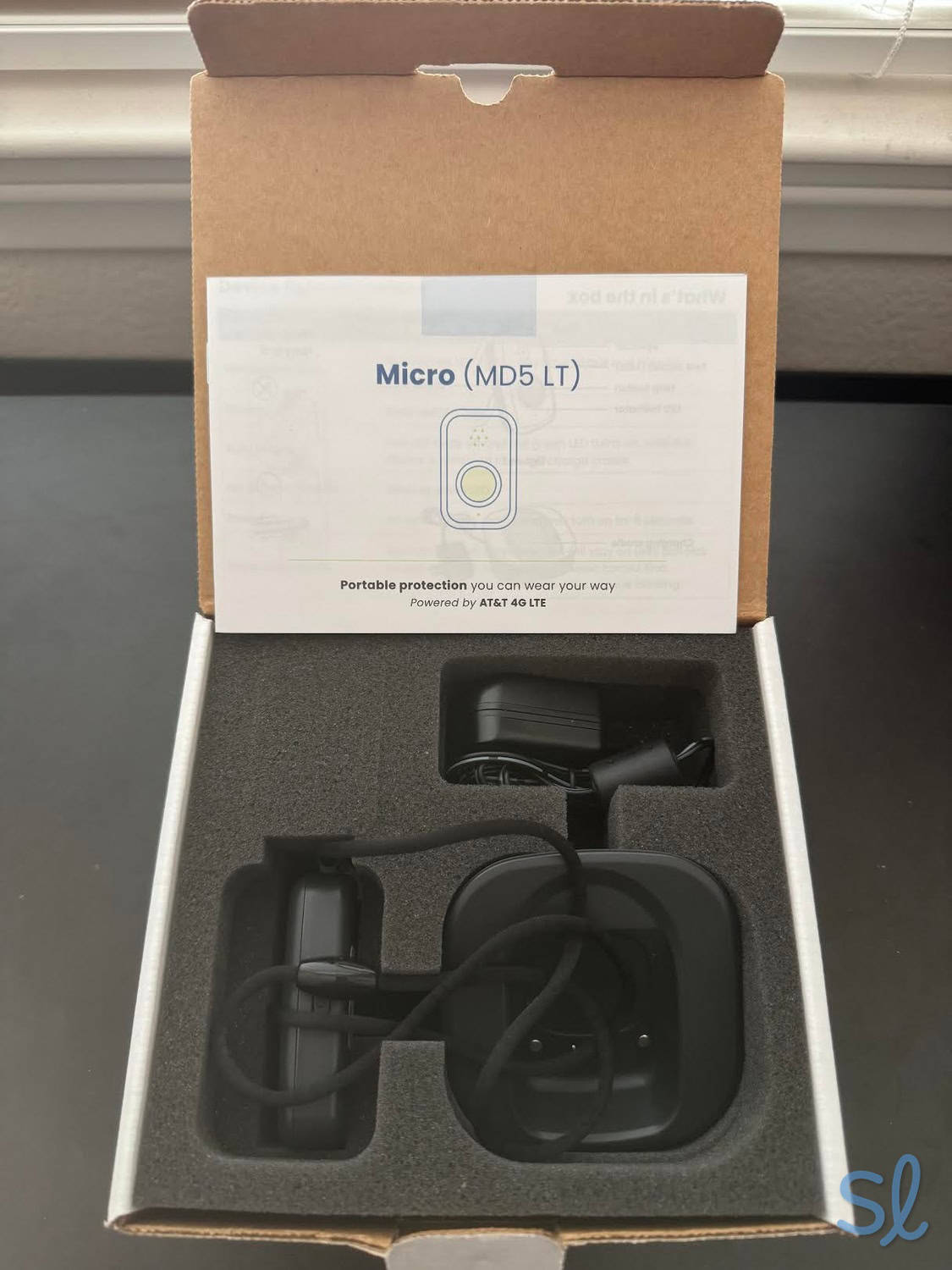
We ordered, unboxed, and tested all of MobileHelp s systems ourselves, including the MobileHelp Micro.
After thoroughly researching a provider’s systems, we conduct hands-on testing for the medical alert systems we review. We then evaluate them for several criteria, including price, value, average response times, ease of use, quality of customer service, equipment quality, and more. Based on our experience with the systems, we give every provider a rating out of five stars. We also ask for feedback from older adults on the systems whenever we can. We strive to make our testing experience as comprehensive as possible so we can provide readers with accurate and unbiased insights.
Here are some of the criteria we use in our evaluation:
- Pricing: We considered price and value for MobileHelp’s systems, evaluating all costs, including monthly fees, shipping costs, any extra fees, and seasonal promotions.
- Coverage: A good medical alert system should have strong and reliable coverage. We tested MobileHelp’s cellular medical alert systems to evaluate whether they held a strong signal both at home and on the go.
- Customer support: Having 24/7 access to customer support is an important feature, as are knowledgeable customer-service agents who can answer your questions and help troubleshoot when issues come up. We considered all modes of contact (email, chat, phone), and spoke with customer support multiple times.
- Response times: We made 10 test calls to MobileHelp’s monitoring center and recorded average response times. We also took notes on our experience and assessed if the agents were helpful and responsive. We also made 10 test calls using our fall detection pendant by simulating test falls.
Visit our medical alert system methodology guide to learn more about how we test medical alert systems.
Frequently Asked Questions About MobileHelp
-
How much does MobileHelp cost per month?
MobileHelp’s medical alert systems can cost anywhere from $24.95 to $49.95 per month, depending on the package you choose.
-
What is the return policy for MobileHelp?
MobileHelp never requires long-term contracts, so you can return your MobileHelp system at any time without penalty. After MobileHelp receives and processes your equipment, they will officially cancel your service and issue a prorated refund for unused service. You do, however, need to pay for return shipping.
-
How much does MobileHelp fall detection cost?
You can add MobileHelp’s fall detection to most systems for $11 per month.
-
Where is MobileHelp located?
MobileHelp’s headquarters are located in Boca Raton, Florida. All of their 24/7 monitoring centers are located in the U.S., servicing all 50 states.
Centers for Disease Control and Prevention. (2024). Older Adult Falls Data.



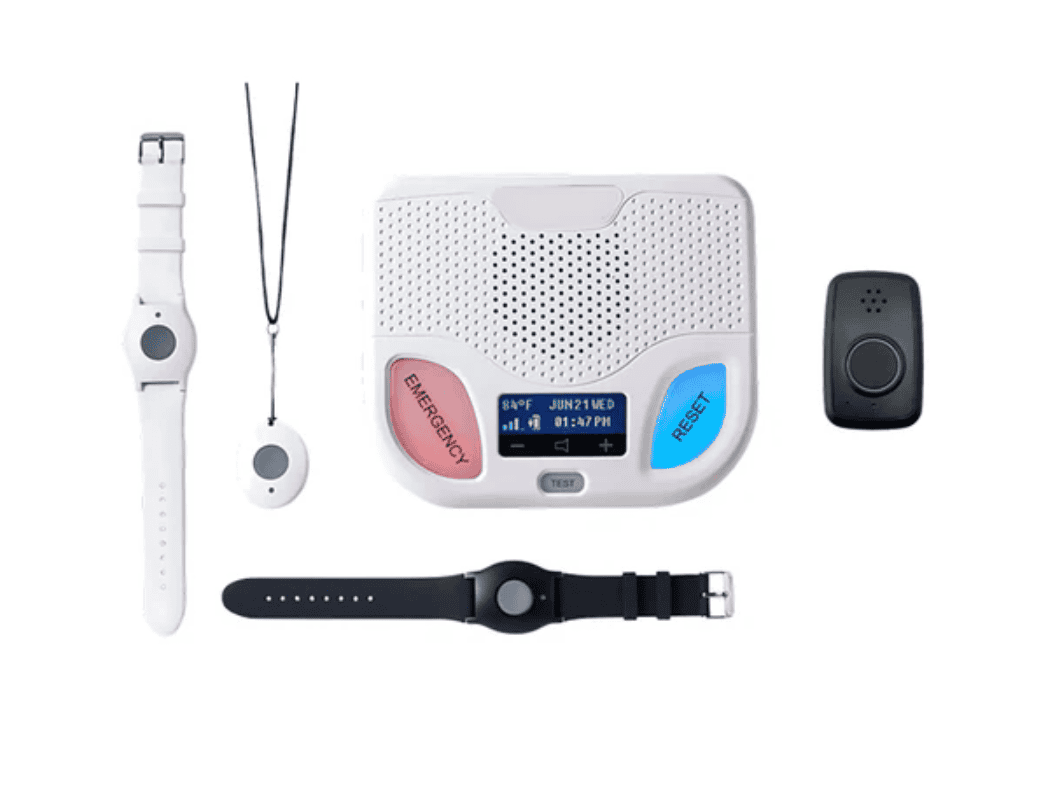 Cost
Cost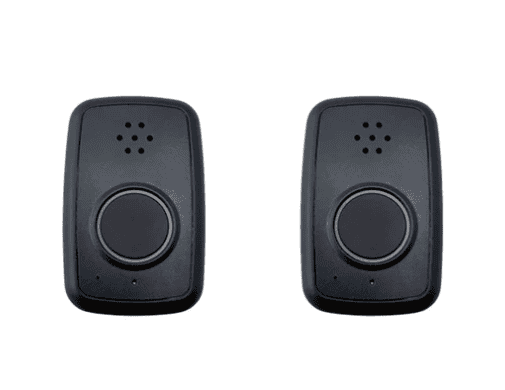 Cost
Cost
